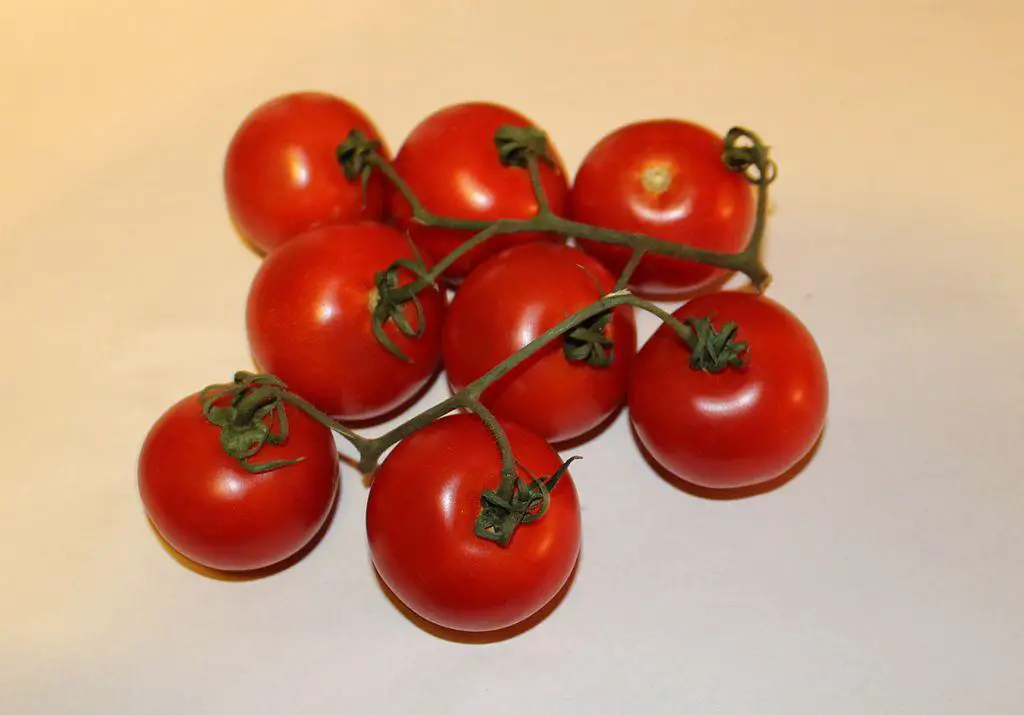If you’re eager to cultivate Campari tomatoes, this comprehensive guide is all you need for a fruitful journey. Before we dive in, let’s get acquainted with some crucial details. Are Campari tomatoes determinate or indeterminate? Well, the good news is that Campari tomatoes are indeterminate, meaning they’ll keep growing and producing fruit throughout the entire season.
Campari tomatoes are renowned for their delectable taste and resistance to late blight and fruit cracking. They fall into the mid-season category of tomatoes and belong to the indeterminate plant type. These plants can stretch up to 48-52 inches in height and spread, bearing 2 oz fruits. In addition, Campari tomatoes are often classified as Salad tomatoes.
It’s worth noting that Campari tomatoes are a hybrid variety, taking approximately 75 days to yield their first ripe fruit. However, please keep in mind that the maturity period can range from 66 to 75 days.
Where Can You Purchase Campari Tomato Plants or Seeds?
If you’re wondering where to buy Campari tomato plants, you have several options at your disposal. Here are a few popular choices:
-
Online:
- Burpee
- Johnny’s Selected Seeds
- Baker Creek Heirloom Seeds
- Park Seed
- Seeds of Change
-
Garden centers: Many garden centers offer Campari tomato plants, especially during the spring planting season.
-
Local nurseries: Supporting local businesses is always a great idea, so check if your local nursery sells Campari tomato plants.
How to Successfully Grow Campari Tomatoes
To ensure a successful Campari tomato harvest, follow these expert tips:
-
Start with seeds or seedlings: You can either sow Campari tomato seeds indoors 6-8 weeks before the last frost or purchase seedlings and transplant them after the final frost. Remember to choose viable Campari tomato seeds.
-
Choose a sunny spot: Campari tomatoes require full sun exposure of at least 6-8 hours daily to thrive and bear fruit. Find a sunny spot in your garden to ensure optimal growth.
-
Prepare the soil: Campari tomatoes prefer well-draining and fertile soil. Enrich your soil by adding compost or manure before planting.
-
Plant the seeds or seedlings: Plant Campari tomato seeds 1/2 inch deep and 2 inches apart. If you choose seedlings, space them 2-3 feet apart.
-
Water regularly: To ensure healthy growth, water your Campari tomatoes consistently, especially during hot and dry weather. Deep watering is crucial, allowing the soil to slightly dry out between waterings.
-
Fertilize regularly: Boost your Campari tomato plants’ fruit production by fertilizing them every 2-3 weeks with a balanced fertilizer.
-
Provide support: Expect vigorous growth from Campari tomato plants. To support their growth, use stakes or cages to prevent them from bending or falling.
-
Keep an eye out for pests and diseases: Campari tomatoes can be vulnerable to various pests and diseases. Regularly check your plants for any signs of issues and take immediate action.
-
Harvest your tomatoes: Wait until your Campari tomatoes turn a vibrant red and feel firm to the touch before harvesting. Use a sharp knife to cut them from the vine, leaving a small portion of the stem attached for better preservation.
Additional Tips for Growing Campari Tomatoes
Here are some extra tips to ensure the best results with your Campari tomatoes:
-
Mulch: Mulching around the plants helps retain moisture and suppress weed growth.
-
Deadheading: Trim off spent flowers to encourage more fruit production.
-
Pruning: Prune your plants to maintain their health and productivity.
-
Frost protection: If frost is expected, consider bringing your Campari tomato plants indoors to protect them.
With a little love and care, you’ll be enjoying the taste of homegrown Campari tomatoes in no time. Happy gardening!
Remember: Campari tomatoes thrive in well-draining soil with a pH range of 6.0 to 6.8. Adding compost or well-rotted manure to the soil provides additional nutrients, ensuring healthier plants.
When transplanting Campari tomato seedlings, make sure to plant them deeply, burying the stem up to the first set of leaves. This helps develop a robust root system, increasing the chances of success.
After planting your Campari tomatoes, provide them with proper care and support. Regular watering, avoiding over-watering, and regular feeding with a balanced fertilizer are essential for their growth.
Ideal Companion Plants for Campari Tomatoes
When selecting companion plants for your Campari tomatoes, consider those that offer mutual benefits and help deter pests. Here are some excellent companion plants for Campari tomatoes:
-
Basil: Not only does basil enhance the flavor of tomatoes, but it also repels pests like aphids and mosquitoes.
-
Chives: Chives work as natural pest repellents, deterring beetles and ants while adding flavor to your tomatoes.
-
Marigolds: These beautiful flowers repel nematodes and whiteflies while enhancing the soil quality.
-
Nasturtiums: Nasturtiums deter aphids, spider mites, and whiteflies. They attract pollinators, aiding in tomato pollination.
-
Spinach: Planting spinach alongside tomatoes helps suppress weeds, improve soil quality, and attract pollinators.
Plants to Avoid Planting Near Campari Tomatoes
Certain plants compete for resources or attract pests, so it’s best to avoid planting them near Campari tomatoes. Here are some examples:
-
Potatoes: Planting potatoes and tomatoes together increases the risk of diseases as they belong to the same nightshade family.
-
Cucumbers: Cucumbers and tomatoes compete for the same nutrients, potentially stunting the growth of both plants.
-
Melons: Similar to cucumbers, melons also compete with tomatoes for nutrients, hindering overall growth.
How Tall Can Campari Tomatoes Grow?

Campari tomatoes fall into the indeterminate category, displaying a vining growth habit that allows continuous growth throughout the season. On average, these tomato plants can reach heights of approximately 6-8 feet (1.8-2.4 m).
However, the height can vary depending on various factors such as growing conditions, pruning techniques, and overall plant health. Pruning is essential when your Campari plants begin producing numerous branches. By removing suckers from the base of the plant and non-fruiting branches, you can promote healthy growth and maximize fruit production.
To ensure their optimal growth, provide proper support such as stakes or tomato cages. Regular pruning and maintenance will not only manage the height but also promote healthier growth.
After your dedicated care and attention, your Campari tomatoes should be ready for harvest. When they turn ripe, pick them for optimal flavor and enjoyment.
Harvesting Campari Tomatoes
Picking Campari tomatoes at their peak ripeness is key. Ripe Campari tomatoes will feel slightly soft to the touch. Avoid harvesting tomatoes that haven’t fully ripened, as they won’t continue to ripen after being picked and won’t offer the same flavorful experience as fully ripe ones.
To harvest, use a sharp knife or pruning shears to cut the tomatoes off the vine, leaving a small portion of the stem attached. This ensures longevity and freshness.
Remember, avoid pulling tomatoes off the vine, as this can cause damage and negatively affect future yields.
For proper storage, keep your tomatoes at room temperature, away from direct sunlight. Refrigeration can negatively impact their flavor and texture. If you have an abundance of tomatoes and need a longer storage period, consider canning or freezing them.
To can Campari tomatoes, blanch them in boiling water, peel off the skin, and pack them into sterile canning jars. Then, process the jars in a boiling water bath for the recommended time based on your altitude. To freeze tomatoes, blanch and peel them, then pack them into freezer-safe containers or bags.
By following these simple steps and providing your Campari plants with the care and support they deserve, you’ll soon be rewarded with a bountiful harvest of juicy and flavorful tomatoes. Happy gardening!
Additional Resources:
- Grow Tomatoes At Home Without Fail (Secret To 8x the results)
- How To Grow Indeterminate Tomatoes
- Companion Plants for Tomatoes
- Transplanting Tomato Seedlings – Tips for Success
- Types of Tomatoes: (40 Plus) Best Tomato Varieties To Plant

